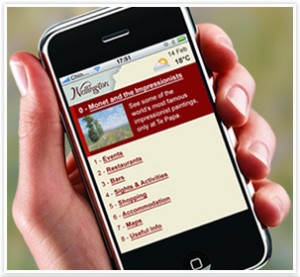March 6th, 2012 → 7:30 am @ iowawebguy // No Comments
Recently Facebook made a game-changing announcement requiring all business pages to change from their current layout to the new “timeline” layout by March 30, 2012. What does this mean?
 Cover Photos
Cover Photos
The new “timeline” layout really allows more control of the look and feel of your business page using a “cover photo”. The cover photo allows you to heavily incorporate your branding. Dimensions are 850 pixels wide by 315 pixels tall.
Facebook is restricting what can be in your cover photo. These items can NOT be in your cover photo:
Good Bye Default Landing Pages
The functionality of directing visitors to a “default” landing page or facebook app is GONE! No more “likegating” where you entice visitors to like you to see more content or offer opt-in promotions. Marketers are going to have to come up with new ways to incorporate Facebook into their strategy.
I think this really blows, as people were really using these landing pages to customize and interact with visitors.
Sticky and Starred Posts
A new feature is a “sticky” post, where you can pin a post to the top of your page. You can also change post dates as well as “star” a post to add more attention to a post.
Page Tabs
Page tabs have been moved from below the profile photo to under the “cover photo” and are limited to 4 spaces (one of which has to be “Photos”). Where before you could have unlimited space, you will really need to think hard about what tabs are important.
App Canvas Size
The appearance of apps has changed as well. They will open up outside your “cover photo” shell and be displayed on the page centered. The size has been increased to 810 pixels from 520 pixels wide.
GAME-CHANGER
These are game-changing to the latest craze of Facebook Business “Fan” Pages. A lot of money and marketing efforts have gone into developing custom apps and default landing pages by thousands of businesses and organization.
What are your thoughts on these changes? Will this affect your marketing plans and strategy utilizing Facebook?
— Iowa Web Guy
September 12th, 2011 → 11:06 pm @ iowawebguy // No Comments
I was sitting with a new client today and one of the first questions she had was “Why do I have a lot of ‘empty space’ on each side of my web site?”
 I immediately thought, “I need to blog about this!” I get this question ALL the time when I’m talking with people when discussing web site layout.
I immediately thought, “I need to blog about this!” I get this question ALL the time when I’m talking with people when discussing web site layout.
The answer is a little complicated, but here we go:
What the heck does that mean?
Resolution:
As technology improves, computer monitors become bigger and allow for more display space (or number of pixels).
Design/Layout:
We design the webpage layout so it will display correctly for the majority of viewers. If a viewer has a larger monitor than the average, they will have the extra space. (The amount of extra space varies from computer monitor resolution to computer monitor resolution.)
The leftover space is the extra space on the sides of your web site!
How do you determine what resolution to target to minimize “extra space”?
I ALWAYS look at website statistics to help me make critical decisions. Here are some real statistics from this website.
As you can see, 93% of viewers have resolutions widths of 1024 or greater! So, 1024 is a safe number to target. 1280 would cover 90%!
Technology Changes…
Technology is ever evolving so these resolutions change all the time. Here is a chart of resolutions in 2008.
See the huge change in resolutions! 1024 went from 47% in 2008 to 4% in 2011. Wow!
Choose wisely!
If you choose too large of a resolution, a visitor that has a smaller resolution will have to SCROLL left and right to view the site! This is very annoying and NOT user-friendly.
–Iowa Web Guy
August 30th, 2011 → 12:36 am @ iowawebguy // No Comments
One of the most common misconceptions surrounding the web right now is a “mobile web site” and a “mobile-friendly web site.” The difference is much more than a name.
Mobile-Friendly Web Site
 A mobile-friendly web site is a traditional web site that is designed to display correctly on a mobile device. The design and functionality are exactly as they would be on your computer. Of course, there are some differences as mobile devices vary on the use of interactivity such as Flash.
A mobile-friendly web site is a traditional web site that is designed to display correctly on a mobile device. The design and functionality are exactly as they would be on your computer. Of course, there are some differences as mobile devices vary on the use of interactivity such as Flash.
Mobile Web Site
Alternatively, a true mobile web site is designed and optimized to display on a mobile device. Because a mobile device has a smaller screen, only “on-the-go” content is displayed. Fewer and lower quality graphics should be used as mobile web sites should also take bandwidth into consideration to speed up load times.
Mobile Web Site Strategy
There are several strategic decisions that will need to be taken into account:
Example
Here is an example using Panera Bread. They do a really good job optimizing their traditional web site for their mobile web site.
Do you have a mobile site and how does it measure up?
–Iowa Web Guy
Blog &Mobile Development &Questions &web development &Web Strategy
August 5th, 2011 → 5:40 am @ iowawebguy // 2 Comments
So, you’ve decided you need a web site. Awesome! It’s the cheapest form of advertising and the best bang for your buck.
 However, to get the best return on your investment (ROI) you should be asking some basic questions in order to develop a PLAN and define GOALS. These questions should be asked BEFORE you begin development.
However, to get the best return on your investment (ROI) you should be asking some basic questions in order to develop a PLAN and define GOALS. These questions should be asked BEFORE you begin development.
1) What is the purpose of your web site?
Are you wanting to:
2) What are your goals and objectives and how do you measure success?
In order to effectively develop a web site, you need to define your goals and objectives early and determine how you will measure success. Then, build your site to accomplish these goals putting metrics (ways to measure) in place in order to evaluate success.
3) Who is your competition and what are they doing?
Do they have a web site? What do you like and dislike about their web site. What can you do to make your site stand out?
4) What should I budget for web site development?
Yep, you knew this one would be here, right? Everything is possible, but you need to set a budget for your site. Depending on the complexity of your site, this will vary by hundreds if not thousands. One of the most common questions I receive is: “How much does it cost to develop a web site?” This question is much like “How much does it cost to build a house?” There are many factors that determine the cost. Look for an upcoming blog post with tools that can help you determine a range of costs. Suprisingly, the answer could be $O.OO (aka FREE).
5) How often will you be updating your site?
This is a very important question. If your site is going to be updated frequently, you’ll want to consider a content management system (CMS) behind the scenes so you can update the site yourself (hopefully easily) to lower your long-term costs. Alternatively, if you don’t plan on updating your site on a regular basis, a CMS system would not be necessary–lowering your up-front costs. (However you’ll have to pay your developer when you want updates.)
These are the basic questions you should ask PRIOR to developing a web site. These questions alone can help you not only streamline the development process, but also save you TIME and MONEY! There are several more questions which I will discuss in upcoming posts.
As always, if you have any questions or comments post below.
— The Iowa Web Guy
August 1st, 2011 → 6:51 pm @ iowawebguy // No Comments
 Welcome to IowaWebGuy.com!
Welcome to IowaWebGuy.com!So, I just had a flashback to my first programming tutorial. I’m pretty sure all developers, no matter your language of choice, completed the “Hello World” tutorial.
Anyway, enough about that and on to the blog! I’ve been consulting on all things web and all things development for several years. I’ve had a lot of help and learned a lot along the way. This blog is my way of giving back!
I’ve been wanting to start this blog for quite some time and I look forward to answering your questions and sharing information you may not even know you need.
Feel free to ask questions in the comments section if they relate to a particular post, or click the “Ask a Question” link on the homepage to ask a new question. I’ll try my best to respond promptly.
— The Iowa Web Guy